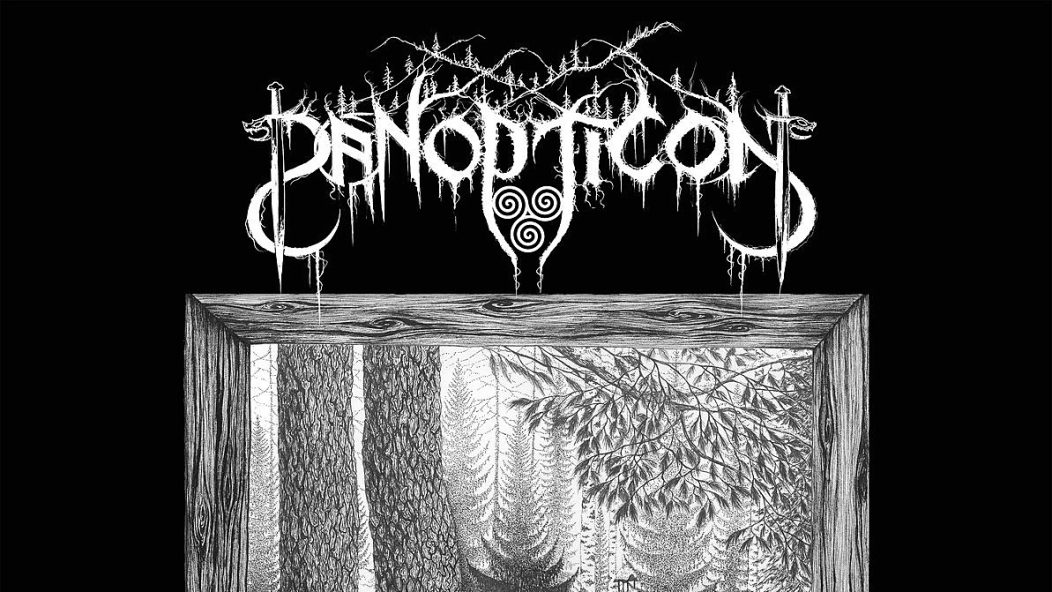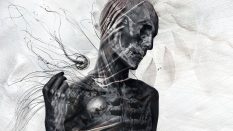
Godless Omniscience: Panopticon's "The Scars of Man on the Once Nameless Wilderness"
![]()
…
Almost exactly ten years after Panopticon‘s self-titled debut — spanning five additional full-lengths and numerous splits — project mastermind Austin Lunn finally delivers his magnum opus: The Scars of Man on the Once Nameless Wilderness. Conceptually the broadest, emotionally involved, and longest work he’s released to date, this cinematic double-feature also poses the greatest risks. From then until now, Lunn has by sheer grit and gristle earned Panopticon’s namesake and reputation in the black metal underground; with 2012’s Kentucky especially, listener expectations (whether bated or hesitant) have risen concomitantly. There’s been a heightened state of anticipation — not a furor, more like a stirring — surrounding momentous releases like these, especially by more renowned artists. Banking on word of mouth, it’s no surprise how official PR was silent regarding The Scars of Man on the Once Nameless Wilderness; upon release, they even made a point to indicate “not one single person was asked to review this album.”
A slightly poised and pompous approach? Maybe, but don’t doubt Lunn’s authenticity until we see what this new album is actually all about, and more importantly, how it functions as black metal (and more). To that point: The Scars of Man on the Once Nameless Wilderness is about a lot, and perhaps too much at once. As sheer artwork, it champions interpretative meaning with its wildly undulating intensities and emotions, inspiring listeners to empty/refill their headspaces entirely. As black metal specifically, though, it prescribes and reinforces a genre tenet: black metal can’t be everything, but its spirit can be found anywhere. This is because black metal is the music of atmosphere, not just music with particularly great atmosphere. It is atmosphere which gets you as close to extrasensory perception as possible — irrevocably permeating but forever indescribable, that artistic sweet-spot between conscious understanding and unaware presence.
It also so happens that that sweet-spot is where your mind is the most open. At every turn — from the hyperbolic blasts of Part 1 to the hypnotic melodies of Part 2 — Lunn guns for the listener’s ability to denounce reality for two straight hours all in service of one key message: humans are currently fucking up nature even though we, collectively, not only have the power to not fuck up nature, but also the power to unfuck the parts of nature we’ve already fucked up; the only thing stopping us from further fucking up nature (and refusing to unfuck the already-fucked parts) is ourselves — our petty battles and politics, our self-involved personal obsessions, and our goddamn inattention to the obvious (and free) beauty which surrounds us all but fails to distract/define us quite as well as, say, our phones and computers do. The sleeve of the first record in the 4LP set reads (written by Lunn):
There is no god, there is no heaven, there is no hell… there is just the vast emptiness that we drift through in this one speck of beauty in the wholly empty dark. We are so fortunate to be in this beautiful place… no divine hand placed us here. There is no order or sense to the madness… there is just this one chance to relish in the fleeting beauty that our ancestors haven’t managed to destroy and we haven’t totally wrecked yet. But instead of soaking up as much of this universally rare beauty, we are content to stare at pictures of it on a screen.
There are two dimensions to this message, though, and they seem to oppose: the good inherent in those who are fighting to stop the destruction versus the darkness inherent in the fact that humanity is, actually, not stopping the destruction (in fact, we’re speeding it up). Immediately, it must be said that The Scars of Man on the Once Nameless Wilderness is not a “political” album; rather, its subject matter happens to be highly politicized, which is in fact part of the problem to begin with. This album was not written for climate change deniers (it wouldn’t convince them anyway); rather it was written for regular, reasonable people who’d genuinely be better planet stewards if they simply paid more attention not only to nature in general but to how nature makes them feel inside. Collectively, this would then result in that all-important cultural change necessary for real action. The music here is about the atmosphere of nature — the connectedness one can feel with nature, the importance of that connection, and the character one begins to adopt by nurturing that connection — and it’s clear that Lunn believes each one of us has the capacity for it. By obvious proxy and for a true-to-self-reason, the album supports the idea of not only preserving nature, but understanding it via lived experience. That all said, The Scars of Man on the Once Nameless Wilderness is by no means unaware of itself in context (neither is Lunn). It just doesn’t undertake an argument for argument’s sake; all it asks is that you take a step back for a couple hours and think about your relationship with nature and what it means you, personally.
…
…
What will deem The Scars of Man on the Once Nameless Wilderness successful as a black metal album is the extent to which it accomplishes this goal. Surprisingly, it’s the album’s second half (inspired by americana, folk, and country) which tunes more accurately into the black metal ethos regarding atmosphere than the first. The first half does deliver furiously, though: extreme texture and vibrancy doled out on excitable swaths of familiar but otherwise energized black metal, highly on-brand. Lunn hasn’t pummeled this fast since Roads to the North (2014) nor this hard since Social Disservices (2011), nor even as clearly/straightforwardly as Autumn Eternal (2015) for that matter. Part 1 of The Scars of Man on the Once Nameless Wilderness feels entirely culminatory as a series of intertwined climaxes exploding in tried-and-true arrangements, with bonuses to boot (like the crazy sweep picking on the hyper-aggressive “En Generell Avsky”). As coherent movements in a grander musical narrative, each song builds upon its predecessor’s intensity and leaves a perfect slate for its ancestor’s pen.
In the shadow of Part 2, though, Part 1 can feel overblown or hyper-maximized, and it’s not just a matter of efficiency, or saying the most with the least amount of noise. Rather, it’s almost an experiment: can the Panopticon brand of nature-themed black metal better deliver its message without the black metal? Probably, but also understand that “delivering a message” is not the primary objective of music, if there even is one. This is where the two halves come into conflict, even if inadvertently, but also where they come to compliment each other. Part 1 relies much more on abstraction and indecipherability to better able to capture the overcoming frisson of an intense nature experience, something akin to seeing the Grand Canyon for the first time. However, embedded within the album’s overall narrative is the idea that you shouldn’t need the Grand Canyon’s near-infinite expansiveness to convince/remind you of nature’s beauty. Calm simplicity can work too (maybe you have particularly nice back yard, or a nature preserve somewhere close); nature’s straightforward serenity indeed speaks louder with fewer tools. Considering the human element, perhaps there’s a duality to nature which, in Lunn’s interpretation, necessitates two musical styles when representing it.
There’s no reason to assume that Lunn sought the traditionalities of americana, folk, and country when composing Part 2, nor were all the base components of those styles necessary for this particular Panopticon blend. In fact, Part 2 spends a good amount of time gazing at its shoes, allowing for long, trailing melodies and moments of guided ambiance. The mechanism whereby black metal is sometimes conflated with shoegaze becomes apparent here (oddly enough, though neither of those styles): structurally, everything is long-form and written for the mind-wandering listener. Lunn’s vocals enter and exit the picture at strategic moments, never getting in the way of the music, but never letting the music do a disservice to itself by not having that special human element to wrap around. His voice has changed, entering a darker, growlier, and rougher character into the story. Songs like “The Wandering Ghost” even echo a Tom Waits-style execution to a newfound benefit.
…
…
As far as differences and connections go, Part 1 feels outward while Part 2 feels inward. The anger and dissatisfaction with current-state humanity pours like blood from a gut-stab on Part 1. But anger always dries up. What’s left is the love which sparked anger in the first place — you have to love something first to feel impassioned enough for anger — and Part 2 feels as down-home and to-the-heart as any huge come-down from the heightened throes of fury. There’s an acute softness to Lunn’s voice here, complimented of course by his multi-instrumentality (guitars, mandolin, harmonica, banjo, etc.), which lends an extreme dynamism to The Scars of Man on the Once Nameless Wilderness as a whole. Certainly, Lunn’s harsh vocals on Part 1 can’t go without mention: their range benefits the aforementioned dynamics, and their raw power illustrates nature’s potential for savage, godless wrath — although, nothing about this album screams “destroy your enemies.”
In the end, instead, the thought left after the madness has settled is home: being home, feeling at home, having things which matter at home and then cherishing them. For Lunn, nature is his home — both an escape and a place of real self-definition. He cherishes the things in nature for what they are, and how they exist among each other in sustainable harmony. For all of us, nature is too our home, and we should likewise be in some sort of symphony with it, even if we’re not able to be physically connected with it all the time. It starts with the individual, and it starts with inspiration, especially in forms so vivid and spirited as The Scars of Man on the Once Nameless Wilderness. Then, it begins with action: get out there and make a connection.
The sleeve of the third record in the 4LP set reads:
I have been living in Minnesota for nearly five years at the time of this writing. My life, my wife’s life, and my children’s lives are built around the beautiful expanse of the northwoods… pulling us ever further and further northwards, towards this place that fascinates me so. The dense forests peppered with patches of pine and birch juxtaposed against the oak savannas and the fields of waving prairie here in central Minnesota where I live all just point north… seductively beckoning us toward the magic of the wilderness of this land.
…











